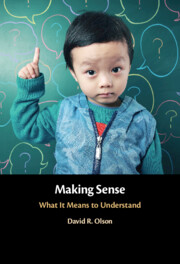Book contents
- Making Sense
- Making Sense
- Copyright page
- Dedication
- Contents
- Figures
- Tables
- Preface
- 1 An Introduction to the Puzzles of Understanding
- 2 Understanding As Feeling and As a Concept
- 3 The Linguistic Basis of Mind
- 4 Subjective Mental States
- 5 Objective Mental States
- 6 Intersubjectivity of Mental States
- 7 Identity Conditions for Feelings and Concepts
- 8 What “Understanding” Means
- 9 The Referential Scope of Understanding
- 10 Understanding and Children’s Theory of Mind
- 11 Understanding and Sense-Making
- 12 Understanding As a Learnable Skill
- 13 Understanding in Everyday Life
- 14 Ascriptivism and Cognitive Development
- References
- Index
7 - Identity Conditions for Feelings and Concepts
Published online by Cambridge University Press: 21 April 2022
- Making Sense
- Making Sense
- Copyright page
- Dedication
- Contents
- Figures
- Tables
- Preface
- 1 An Introduction to the Puzzles of Understanding
- 2 Understanding As Feeling and As a Concept
- 3 The Linguistic Basis of Mind
- 4 Subjective Mental States
- 5 Objective Mental States
- 6 Intersubjectivity of Mental States
- 7 Identity Conditions for Feelings and Concepts
- 8 What “Understanding” Means
- 9 The Referential Scope of Understanding
- 10 Understanding and Children’s Theory of Mind
- 11 Understanding and Sense-Making
- 12 Understanding As a Learnable Skill
- 13 Understanding in Everyday Life
- 14 Ascriptivism and Cognitive Development
- References
- Index
Summary
Feelings are conscious states evoked by situations and, presumably, experienced by all animals. Most of us judge the feelings of young children and other animals as sufficiently similar to our own that we attribute or ascribe feelings, understandings, and beliefs to them. Clearly, the ascription of mental states, a verbal practice, depends on the availability of concepts. The question is whether the states themselves depend on such a verbal practice. I have suggested that they do. Those concepts, represented as the senses of the word “understanding,” go beyond feelings to include both correctness (Chapter 5) and intersubjectivity (Chapter 6). Thus, the relationship between subjective feeling and the concepts representing those feelings may be compared in terms of their “identity conditions,” that is, the features that distinguish them that came to light in the discussion of the views of Taylor and Nussbaum and Jackendoff (2012).
- Type
- Chapter
- Information
- Making SenseWhat It Means to Understand, pp. 73 - 80Publisher: Cambridge University PressPrint publication year: 2022

